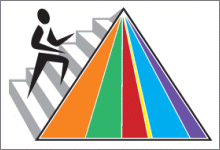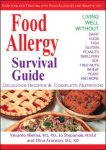|
The latest food pyramid, unveiled in 2005 by the U.S. Department
of Agriculture (USDA), was intended to be simple and improved.
Critics, however, say the pyramid, called MyPyramid, is hard
to understand, too abstract, and missing some vital components.
"Where's the food?" asked Marion Nestle, a nutrition
professor at New York University after looking at the pyramid
symbol. "There's no 'eat less' message here. There's
nothing about soda or snacks or about how many times you should
eat."
|

This symbol is intended to promote www.mypyramid.gov,
where you can get an eating plan based on your age,
gender and exercise level. But not everyone has access
to the Internet, critics say.
|
She's referring to the updated MyPyramid image (pictured
at right), which consists of colored bands of varying colors,
and a figure climbing up the side. Here's a breakdown of what
the bands mean:
The major problem, critics say, is that there are no labels.
Unless you have access to the corresponding Web site, the
image means absolutely nothing.
"The specific information that you need about how to
eat is only on the Web site. So the whole educational tool
is now Web-based. And you have to go deep into the Web site
to even find the specifics about what to eat in what quantities,"
says Michele Simon, director of the Center for Informed Food
Choices in Oakland, California.
Yet, according to Eric Hentges, USDA head of nutrition policy
and promotion, the reason the image is so abstract is because
the 2005 Dietary Guidelines for Americans are the most complicated
to date, including 23 recommendations, and an additional 18
for children, the elderly and other groups. Quite simply,
he said, there was no way to fit all those recommendations
into one symbol.
Sonja Tuitele of Wild Oats Markets felt otherwise. "By
replacing one pyramid with 12, the government has made this
advice more complicated than it needs to be. There are simple
key principles about healthy eating that truly do work for
all Americans, and those could have been represented on one
symbol," she said.
Too Politically Correct? And What About the Sugar?
|

At the risk of offending someone, critics say, the
USDA stopped short of telling Americans to limit their
intake of certain foods, like sugar or sugary beverages.
|
Aside from the missing information, that only those with
the Internet can access, critics have suggested that the pyramid
is structured so as not to offend any specific food companies
or commodities.
"I would say this is a clear win for the food industry,"
Nestle said.
And Margo G. Wootan, Nutrition Policy Director of the Center
for Science in the Public Interest, had this to say, "This
new symbol is a missed opportunity. USDA seems to have bent
over backward to avoid upsetting any particular commodity
group or food company by not showing any foods that Americans
should eat less of."
Meanwhile, health experts know that one
of the biggest hurdles facing the nation's battle with weight
is sugar, yet there is nothing in the pyramid that suggests
people eat less sugar or drink less sugary drinks (except
for one recommendation buried on the Web site to "go
easy on fruit juice").
Likewise for fats and oils. The image, if you know what the
yellow slice means, implies that fats and oils should be a
minimal part of your diet. But it makes no distinction between
healthy fats, like olive oil, and unhealthy ones, like trans
fats. Only when you go to the Web site does it read "Make
most of your fat sources from fish, nuts, and vegetable oils."
|
Struggling With Food Allergies?

If you have food allergies, the food pyramid will not
help you out … but The Food Allergy Survival Guide
will. You'll find common sense answers and real advice
on where to seek support on exactly how to change your
body with a full spectrum of information regarding food
and health issues, delicious recipes and a guide to
complete nutrition, no matter what your needs.
Learn
More About The Food Allergy Survival Guide Now!
|
The grain "slice" is also misleading. It represents
the largest section of the diet, but again without qualifying
the difference between whole grains and refined ones. When
you get to the Web site, it says to "make half your grains
whole," which many nutritionists feel is too low.
"The pyramid is incredible to me," Dr. Carlos Arturo
Camargo Jr., an epidemiologist at the Harvard School of Public
Health, told the New York Times. "The whole concept of
replacing unhealthy foods with healthy food is very hard to
find. I'm pretty skeptical that this graphic is going to produce
many healthy people, except for some highly motivated ones."
What Can You do to Eat Healthier?
If you're looking for some quick tips to make your diet healthier,
here are 10 simple tips, according to a sampling of nutritionists:
-
Cut out excess "empty" calories like those
from soda, candy, cookies, sweetened drinks and chips
first.
-
Eat more vegetables, fruits and other whole, fresh foods.
-
Eat less processed foods and oils, sugar and caffeine.
-
Eat whole fruit instead of drinking
fruit juice.
-
Bake, grill, steam or broil food instead of frying it
(fewer calories and better for health and energy).
-
Drink water as your primary beverage.
-
When choosing grains, pick items that have whole grains
listed as the first ingredient on the label.
-
Get healthy fats by eating foods such as low-mercury
fish, nuts, avocados, olives and olive oil.
-
Sit down to a regular, family mealtime everyday (or
as often as possible), including foods you've cooked at
home.
-
Limit take-out food, fast food and pre-packaged convenience
foods.
Recommended Reading
America's
Consumption of Added Fats and Sugars Continues: How to Avoid
it
Those
Who Don't Diet are Better at Improving Health Than Those Who
Do Diet
Sources
Salon.com
ConsumerAffairs.com
Sfgate.com
MyPyramid.gov
|